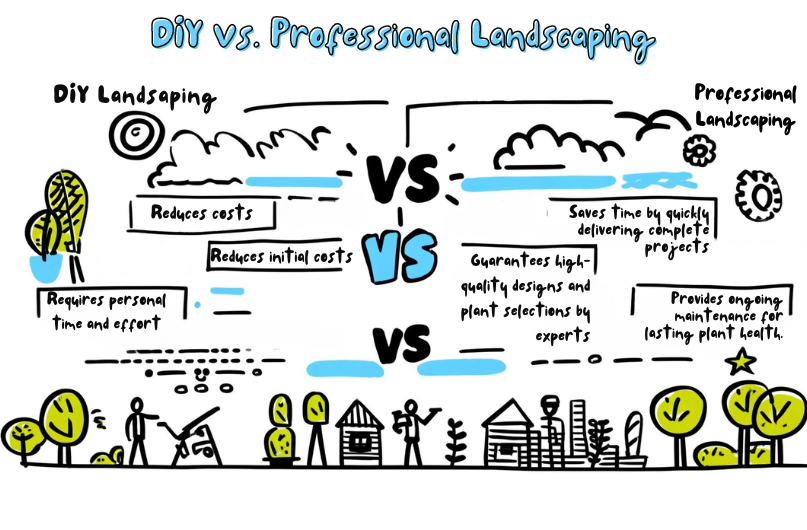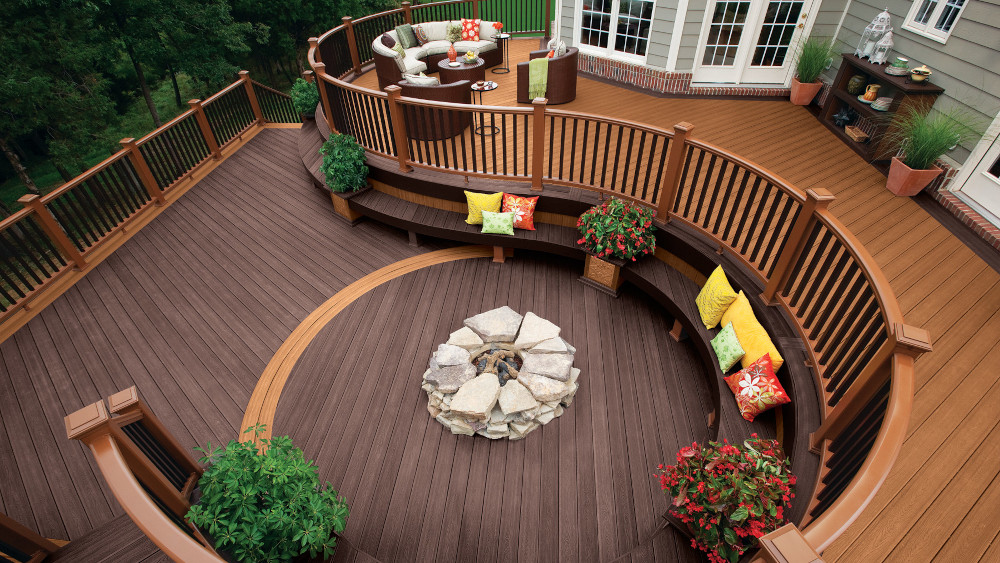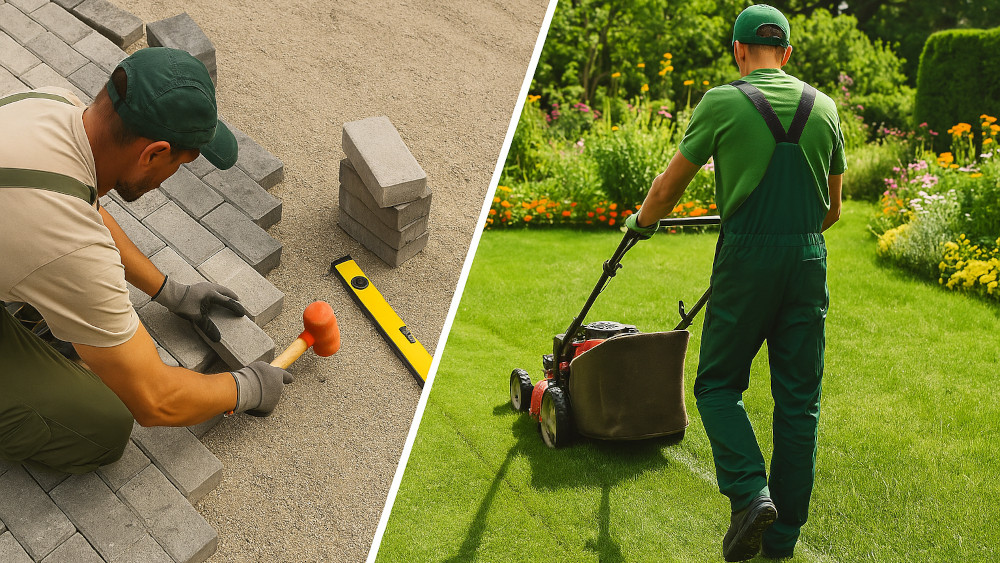When you stand at the crossroads of deciding between DIY and professional landscaping, you’re faced with a blend of cost implications, expertise demands, and time commitment. Going the DIY route might save you some cash initially, but are you prepared to handle the unexpected challenges and potential for error? Conversely, professionals offer reliability and a polished result but at a premium. This decision not only affects your wallet but also the long-term appeal and functionality of your outdoor space. Are you ready to weigh these factors carefully to determine the best route for your home’s landscape?
Main Points
- DIY landscaping reduces initial costs but may incur extra expenses due to potential errors.
- Professional landscaping saves time and ensures high-quality design and plant selection.
- DIY projects require significant time and effort, suitable for those with the availability and interest.
- Professional services offer ongoing maintenance, enhancing plant health and landscape longevity.
- Hiring a professional can provide access to specialized tools and materials, optimizing the sustainability of the landscape.
Evaluating Costs and Budget
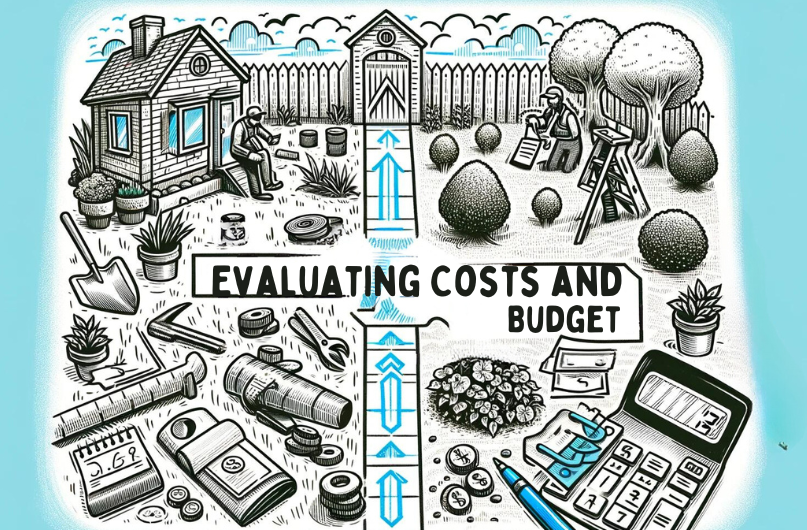
When pondering landscaping options, it’s crucial to weigh the costs and budget implications of DIY efforts versus hiring a professional. You’ll find that DIY can greatly reduce labor costs, yet it’s important to account for the expenditure on tools, materials, and equipment. If you lack experience, your DIY mistakes might require professional fixes, increasing your initial budget.
A thorough budget plan is your best ally here. Start by listing all potential expenses, including those less obvious ones like tool rental or purchase. This foresight prevents the surprise of unforeseen costs and keeps your project financially manageable.
On the other hand, hiring a professional landscaper does mean a higher initial outlay. However, their expertise not only reduces the risk of costly errors but also ensures a more long-lasting outcome. They’ve access to commercial-grade products that, while more expensive, often lead to savings over time due to their durability and effectiveness.
For a balanced cost comparison, consider both immediate and long-term financial impacts. Budgeting tips include seeking multiple quotes and asking for detailed breakdowns from professionals, or thoroughly researching material costs if you choose the DIY route. This approach ensures you make an informed decision aligned with both your financial and aesthetic goals.
Time Investment and Effort
After evaluating the financial aspects, you’ll also need to contemplate the time and effort required for your landscaping project. DIY landscaping isn’t just about digging and planting; it involves extensive research, planning, and physical labor. You’ll find yourself spending hours on tasks like deadheading, mowing, and controlling weeds. Additionally, the necessity to purchase and maintain the right equipment can greatly add to your time commitment.
On the flip side, hiring professional landscapers can streamline this process. These experts bring efficiency to the table, handling the same tasks much more quickly due to their expertise and specialized tools. This not only saves you time but also spares you the exhaustive effort of regular maintenance. Scheduled maintenance visits by professionals ensure that your garden or lawn is tended to promptly, enhancing time savings and allowing you more leisure to enjoy your outdoor space without the constant worry of upkeep.
Choosing between DIY and professional landscaping ultimately hinges on your available time and willingness to invest effort. If you’re pressed for time or prefer not to dive deep into the intricacies of landscaping work, leaning on professionals might be the more efficient route to take.
Expertise and Design Quality
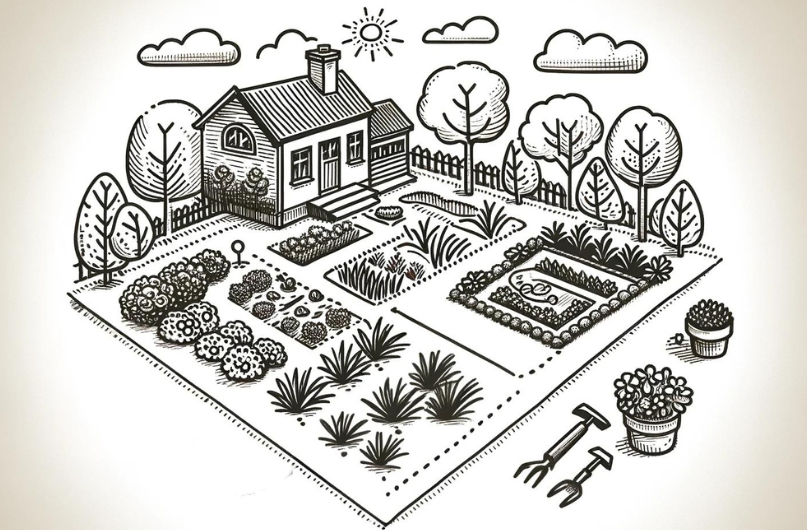
Why should you consider a professional for your landscaping needs? The expertise advantages are compelling. Professionals possess a deep understanding of design principles and can tailor these to fit your specific vision and the unique characteristics of your property. They’re adept at selecting suitable plants and materials that not only thrive in your local environment but also complement each other, ensuring a coherent and visually appealing landscape.
However, it’s important to recognize the design expertise limitations when opting for professional landscaping. While professionals can offer high-end, customized solutions, these often come with a higher price tag. The level of creativity and innovation might also be constrained by your budget or the landscaper’s style preferences, which mightn’t always perfectly align with your personal taste.
That said, the ability to transform outdoor spaces into functional and aesthetically pleasing areas is a significant benefit that professionals bring. They apply specialized knowledge that enables them to foresee and solve complex design challenges, integrating various elements into a seamless whole. If you’re aiming for a landscape that stands out and adds value to your property, investing in professional expertise could be the wise choice.
Long-Term Maintenance Considerations
Considering long-term maintenance, hiring a professional landscaper can save you time and guarantee your garden remains in top condition. Professionals offer ongoing care, focused on best appearance and plant health, which is essential for your landscape’s longevity. They possess the expertise to apply proactive solutions and timely repairs, ensuring that each plant thrives and any potential issues are addressed before they escalate.
You’ll appreciate the peace of mind that comes with knowing your garden is under expert care. Professional landscapers prevent costly mistakes that can arise from inexperience. Without proper knowledge, DIY efforts might inadvertently harm your plants or lead to poor soil conditions, affecting the overall health and aesthetic of your landscape. Additionally, experts maintain a cohesive look, enhancing your home’s curb appeal consistently over the years.
In engaging a professional, you’re not just paying for their immediate service but also investing in the future of your outdoor space. This approach secures the longevity of your landscape, ensuring it remains vibrant and functional. Therefore, while the initial cost might be higher, the long-term benefits of professional maintenance are invaluable, providing both practical advantages and visual pleasure.
Assessing Resource Availability
When deciding between DIY and professional landscaping, it’s important to evaluate the resources you have at your disposal. Evaluating resource availability and skill level will guide you in making an informed choice that aligns with your capabilities and expectations.
Here are critical points to ponder:
- Tools and Equipment: For DIY, you’ll need to acquire various tools and equipment, which can be costly. Professionals come equipped with high-quality, commercial-grade items.
- Expertise and Knowledge: You might lack detailed knowledge about plant selection, design, and local environmental factors. Professionals offer extensive expertise in these areas.
- Time Commitment: DIY projects require a significant time investment. If you’re tight on time, hiring a professional could be more efficient.
- Quality of Materials: Professionals have access to top-tier materials and plants more suited to your local climate and soil, often at better prices due to industry connections.
- Long-Term Viability: Consider whether you have the skill to execute and maintain a landscape design that will thrive long-term. If unsure, professional services might guarantee greater success and sustainability.
Understanding these factors will help you decide which route—DIY or professional—best suits your landscaping goals and resource availability.
Warranties
Professionals offer guarantees on their work, materials, and plants, which can provide peace of mind. This protects the investment you’ve made in your landscape design. Reputable landscaping companies will guarantee plant survival for a certain period, often 1 year. They’ll also guarantee their hardscaping like patios, walls, walkways etc for structural defects.
If something goes wrong down the road, like plants dying or hardscaping falling apart, you can get the issues fixed without additional charges within the warranty period. With DIY, you have no recourse if your work ends up with problems. If your plants die or a patio settles, you’ll have to put in more money and effort to fix it yourself. The warranties from professionals help ensure you get lasting results.
Frequently Asked Questions
Can Landscaping Improve My Home’s Resale Value?
Yes, landscaping can greatly enhance your home’s resale value by improving curb appeal and aligning with market trends. You’ll attract more buyers and potentially increase your selling price with a well-maintained exterior.
Are There Eco-Friendly Landscaping Options?
Yes, you can adopt eco-friendly landscaping options by utilizing sustainable materials and implementing water conservation techniques, ensuring your garden not only thrives but also respects and improves the local environment.
How Often Should Landscaping Designs Be Updated?
You should update your landscaping designs every 3 to 5 years to keep up with design trends and adjust to budget considerations. This guarantees your outdoor space remains functional, attractive, and aligned with current styles.
Can Landscaping Help With Home Insulation?
Yes, landscaping can improve your home’s insulation. By strategically positioning plants and using insulation materials effectively, you’ll optimize natural barriers against weather, potentially reducing your energy costs and improving comfort.
What Are the Best Plants for Allergy Sufferers?
You’ll want to choose plants carefully to minimize allergy triggers. Opt for allergy-friendly options like female holly bushes, which produce less pollen. Prioritize plant selection that aligns with your specific sensitivity needs.
Conclusion
In deciding between DIY and professional landscaping, consider your budget, time, and skill level. DIY can cut costs but may risk mistakes and require tool investment. Professional services offer expertise and quality but at a higher price.
Assess your resources and how much personal involvement you desire in the project. Weigh these factors carefully to choose the best approach for creating a beautiful and sustainable outdoor space that meets your needs and preferences.
